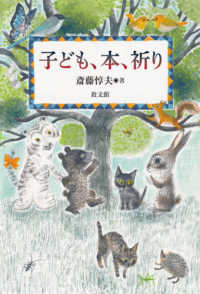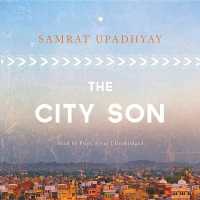Full Description
This innovative handbook is a state-of-the-art of the intersection of health and environmental humanities, capturing its multidisciplinary creative spirit in showcasing key concepts and tools, on-the-ground innovations, and conversation pieces between established and emerging scholars.
The handbook captures the dynamism of the cross-disciplinary dialogue between these fields through a unique structure, one which blends the elements of a traditional handbook with interventions to reinforce conversations between scholars across these fields. The collection features short keyword pieces across three sections - Concepts and Themes; Tools and Methods; and Sites and Scales. Each of these sections also includes academic case studies and short pieces on creative work from practitioners and activists in these fields, bookended by 'conversation' pieces, in which two academics from these disciplines cover key issues and debates in their respective sections. Taken together, the volume offers a fresh approach to work at the intersection of health and environmental humanities, exploring concepts of shared importance between the fields, the latest scholarly developments, and the opportunities and challenges in bringing them together.
The handbook will be a valuable resource for scholars in health humanities, medical humanities, and environmental humanities, as well as related disciplines such as literary studies, philosophy, anthropology, and geography.
Contents
Introduction, PART I: CONCEPTS, Defining the Subject 01. WELLBEING: Wellbeing and Boggy Knowledge in More-Than-Human Worlds Joshua Cohen, Laura Harrington, Fiona MacDonald, Jenny Sharman, 02. NATURE AND THE ENVIRONMENT: A Conceptual Overview Lorina Buhr, 03. CONVERSATION: BODIES: Traversing and Conversing Across Borders Lydia Tuan, Joel Olea-Calixto, Framing Concepts, 04. SPACE AND PLACE: Where culture, capital, and wellbeing collide Emily McGiffin, 05. EQUITY AND JUSTICE: Indigenous Environmental Knowledge Meg Parsons, Leane Makey, 06. DISABILITY: Why We Need Disability Studies: A Disability-Based Approach to Environmental Humanities Wei Yu Wayne Tan, 07. TIME AND TEMPORALITY: Relating through crisis and terminality Yianna Liatsos, 08. PROGRESS: Progress: False Friend and Real Hope Vanessa Heggie, PART II: METHODS, Material Methods, 09. ARCHIVES, Archival sources in health and environmental humanities research, Maria Teresa Marangoni, 10. OBJECTS: Objects: A planet of things Alice Would, 11. REMAINS: Methods for Studying Remains Sarah A. Kennedy, Deborah Neidich, Jennifer Farquhar, Arts-based Methods, 12. CREATIVE AND ARTS-BASED METHODS: Drama, collages, and games: Reimagining antimicrobial resistance through creative methods Enrique Castro-Sánchez, 13. NARRATOLOGY: Malvina Reynolds, environmental human stressors, and the medical narratology of music, Nathan Fleshner, 14. PERFORMANCE: Embodying the apocalypse: Spectral strategies for creating performance at the end of the world anna thompson, taylor knight, 15. VISUAL CULTURE: Filmmaking in participatory research and knowledge translation at the intersections of health and the environment Sarah Van Borek, Collaborative Methods, 16. CONVERSATION: CO-PRODUCTION AND COLLABORATION Gillian F. Black, Chevon Smith, Bulelwa Somlota, Amber Abrams, 17. PARTICIPATORY METHODS AND COLLABORATION: Unsettling participatory ideals: Critical reflections on collaborative research in health and environmental studies Shelda-Jane Smith, Rosie Knowles, Bryony Ella, 18. COLLABORATING BEYOND HUMANITIES: Of culture, parasites and ethnographers: The place of anthropology in global health research Lisa Dikomitis, Brianne Wenning, Helen Price, Embodied Methods, 19. CONVERSATION: PHENOMENOLOGY: Phenomenology of health and environmental art activism Havi Carel, Sari Carel, 20. PROVOCATION: ETHNOGRAPHY: Reproducing worlds: Ethnographic approaches in environmental health research Tessa Moll, 21. CONVERSATION: DECOLONIAL AND FEMINIST RESEARCH: Unpacking exposure and accountability: A dialogue on decolonial and feminist research across the Americas M. Yoalli Rodríguez Aguilera, Sofía Zaragocín, 22. MOVING METHODS: Moving research: Walking and other mobile methods Abbi Flint, Clare Hickman, PART III: CASE STUDIES, Elements, 23. AIR: The environing air and health-environmental crisis Tatiana Konrad, 24. PROVOCATION: WATER: Water qualities: Thinking through intersections of health and environmental humanities Marianna Dudley, 25. EARTH: The long-term effects of extractive industries Sarah A. Kennedy, Karen Durand Cáceres, Sarah J. Kelloway, Sophie Baggett, 26. FIRE: After the fire: Wonder, ecological grief and place-based interdisciplinary research in the Anthropocene Vincent J. Miller, David Paul Bayles, Frederick J. Swanson, Bodies, 27. MICROBES: Intimate strangers and invisible enemies: Microbe-human-environment relationships James Stark, 28. INFECTIOUS DISEASE: Tuberculosis in the Philippines (1970-1990s): A historical analysis of environmental determinants and health policy challenges Arnab Chakraborty, 29. FUNGI: Fungal bodies: A short guide Katja Garson, 30. INSECTS: Histories of Integrated Pest Management in the FAO and WHO Erinn E. Campbell, Timothy Sim, 31. SKIN: When the skin speaks in the tropics: Peering into environmental toxicity through touch, symptoms and metaphors in HIV Purbita Das, 32. SENSES: Sonic siege: noise pollution and the embodied existence Ayşegül Yıldırm, 33. TRUNKS: Rethinking Scoliosis through art, nature, and embodied experience Catherine Baker, Nina J. Morris, 34. ANIMALS: How do monkeys make toast? Animal health and history in the environmental humanities Oliver Pritchard Moore, 35. PROVOCATION: BODIES IN SPACE: Health, environment, and the making of astronauts Jordan Bimm, Places, 36. OCEANS: Oceanic Empatheatre: Sculpting empathy with and for ocean communities, towards a more inclusive and empathetic ocean governance Dylan McGarry, Neil Coppen, Mpume Mthombeni, 37. WETLANDS: Reflections on the swirling currents of co-production Will Freeman, 38. PROVOCATION: SHORELINE: Fishing for well-being Marieke Norton, 39. TOXIC PLACES: Health Literacy within Narrating Nuclear Toxic Legacy: Karen Hesse's Phoenix Rising Inna Sukhenko, 40. CONVERSATION: BUILDINGS: Cross-cultural perspectives on architectural history, healthcare architecture, and environmental humanities Uğurgül Tunç, Joana Balsa de Pinho, Lucienne Thys-Şenocak, 41. CITIES: Cities, hazards and their hinterlands Keir Waddington, 42. PROVOCATION: SMART CITIES: Will smart cities have trees? Amy K. McLennan, Thomas Biedermann, 43. PROVOCATION: DIGITAL SPACES: Confronting industry hype: Why health and environmental humanities need to pay attention to AI Mél Hogan, Jacqueline Jenkins, Index








